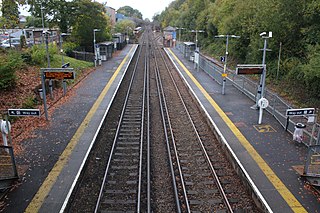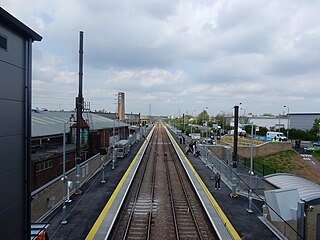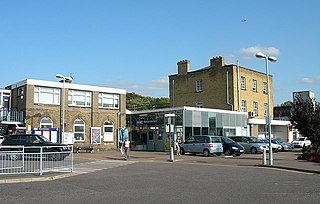
Bishop's Waltham is a medieval market town situated at the source of the River Hamble in Hampshire, England. It has a foot in the South Downs National Park and is located at the midpoint of a long-established route between Winchester and Portsmouth. It is home to the ruins of Bishop's Waltham Palace, a Scheduled Ancient Monument under English Heritage management, and a well-preserved high street with many listed buildings which now house independent shops.
The Northern & Eastern Railway (N&ER) was an early British railway company, that planned to build a line from London to York. Its ambition was cut successively back, and it was only constructed from Stratford, east of London, to the towns of Bishop's Stortford and Hertford. It was always short of money, and it got access to London over the Eastern Counties Railway (ECR). It was built at the track gauge of 5 ft, but it converted to standard gauge in 1844.

The Weardale Railway is an independently owned British single-track branch line heritage railway between Bishop Auckland, Witton-le-Wear, Wolsingham, Frosterley and Stanhope. Weardale Railway began services on 23 May 2010, but decided to run special trains rather than a scheduled service for the 2013 season. The line was purchased by the Auckland Project in 2020 with a view to restarting passenger services. In 2021, a bid was submitted to the Restoring Your Railway fund. In October 2021, the Department for Transport allocated funding for the development of a business case.

Ickenham is a London Underground station located in Ickenham in the London Borough of Hillingdon. The station is on the Uxbridge branch of both the Metropolitan line and Piccadilly line, between Ruislip and Hillingdon stations. It is in Travelcard Zone 6.

Enfield Lock railway station is on the West Anglia Main Line, it is in Enfield Lock in the London Borough of Enfield, London. It is 11 miles 65 chains (19.0 km) down the line from London Liverpool Street and is situated between Brimsdown and Waltham Cross. Its three-letter station code is ENL and it is in Travelcard zone 6.

The Lea Valley lines are two commuter lines and two branches in north-east London, so named because they run along the Lower Lea Valley of the River Lea. They were part of the Great Eastern Railway, now part of the Anglia Route of Network Rail.

Broxbourne railway station is on the West Anglia Main Line serving the towns of Broxbourne and Hoddesdon in Hertfordshire, England. It is 17 miles 17 chains (27.7 km) down the line from London Liverpool Street and is situated between Cheshunt and Roydon. Its three-letter station code is BXB and it is in fare zone B.

Cheshunt is a National Rail and London Overground station in Cheshunt, Hertfordshire, England. On the National Rail network it is on the West Anglia Main Line, 14 miles 1 chain (22.6 km) from London Liverpool Street and situated between Waltham Cross and Broxbourne. On the London Overground network it is one of three northern termini of the Lea Valley lines.

The Eastleigh–Fareham line is the railway line from Eastleigh to Fareham in England. At Eastleigh, trains join the South West Main Line for onward travel to Basingstoke and London Waterloo. At Fareham trains join the West Coastway Line for onward travel to Portsmouth.

Botley railway station serves Botley and the surrounding areas in the English county of Hampshire. The station is on the railway line between Eastleigh and Fareham, 78 miles 72 chains (127.0 km) from London Waterloo.
The Bishop's Waltham branch was a railway line in Hampshire, England. It was made by a locally promoted independent company, the Bishop's Waltham Railway company. It ran from Bishop's Waltham to Botley on the Eastleigh–Fareham line of the London and South Western Railway (LSWR). The line opened on 1 June 1863.

The Coventry to Nuneaton Line is a railway line linking Coventry and Nuneaton in the West Midlands of England. The line has a passenger service. It is also used by through freight trains, and freight trains serving facilities on the route.

Lea Bridge is a railway station on the line between Stratford and Tottenham Hale on the Lea Valley Lines, which reopened on 15 May 2016 with the full service beginning on 16 May 2016, operated by Greater Anglia.

Aber railway station is a railway station serving the town of Caerphilly, south Wales. It is a stop on the Rhymney Line 8+1⁄4 miles (13.3 km) north of Cardiff Central on the Valley Lines network.

Bishop's Stortford railway station is on the West Anglia Main Line serving the town of Bishop's Stortford in Hertfordshire, England. It is 30 miles 27 chains (48.8 km) down the line from London Liverpool Street and is situated between Sawbridgeworth and Stansted Mountfitchet stations. Its three-letter station code is BIS.
There are 22 disused railway stations on the Bristol to Exeter line between Bristol Temple Meads and Exeter St Davids. The line was completed in 1844 at which time the temporary terminus at Beambridge was closed. The most recent closure was Tiverton Junction which was replaced by a new station} on a different site in 1986. 12 of the disused stations have structures that can still be seen from passing trains.
The Bishop's Stortford–Braintree branch line was an 18-mile-long (29 km) railway line connecting existing railways at Bishop's Stortford, Dunmow and Braintree. It was promoted independently by the Bishop’s Stortford, Dunmow and Braintree Railway (BSD&BR) company, but the directors failed to generate subscriptions, or to manage the construction properly. The Great Eastern Railway was the dominant railway company in the area, and saw the line as a blocker, to prevent the incursion of a rival line, so they felt obliged to support it. However they themselves had other pressing priorities, both managerial and financial, at the time, and for some time the construction was in abeyance.
The Gosport and Cosham lines were a collection of railway lines in southern Hampshire. Most of the lines are now closed but some elements are still in use, forming part of the West Coastway line. The lines originally linked to the main London to Southampton line via the Eastleigh–Fareham line and subsequently with a line from Southampton via Bursledon, both of which are still in use.
Durley Mill is a hamlet between Botley and Bishops Waltham in Hampshire, England. It once had a small intermediate halt on the Bishops Waltham branch.

Bishops Waltham railway station was a railway station in Bishop's Waltham, Hampshire, England. The station was the terminus of the 3.75 mile branch line that connected to the main line at Botley railway station. It opened on 1 June 1863, and closed to passengers on 2 January 1933. After closure to freight in 1962 it was demolished in 1965 and the site is now a roundabout.














